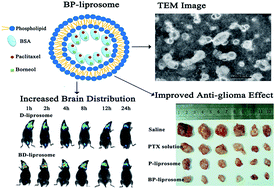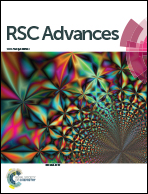Co-encapsulation of borneol and paclitaxel by liprosomes improved anti-tumor effect in a xenografted glioma model
Abstract
In this study, a borneol (BOR) and paclitaxel (PTX) co-encapsulated lipid–protein nanocomplex (BP–liprosome) was developed for the treatment of brain glioma. The prepared BP–liprosome had small particle size (107.5 ± 3.2 nm), high entrapment efficiency for BOR (85.89 ± 0.78%) and PTX (90.40 ± 1.2%), and exhibited sustained release profiles in vitro. Raman spectra showed that both PTX and BOR existed in the BP–liprosome in a noncrystalline state. In vivo imaging showed that the BP–liprosomes exhibited stronger fluorescence intensity in the brains of mice than PTX encapsulated lipid–protein nanocomplexes (P–liprosome) without BOR. Furthermore, the results of the in vivo distribution study indicated that the BP–liprosome significantly increased the accumulation of PTX in the brain compared to the P–liprosome after i.v. administration in mice. Most importantly, the BP–liprosome exhibited a stronger anti-tumor effect in C6 tumor-bearing mice than the P–liprosome. The tumor inhibition rates of BP–liprosome, P–liprosome and PTX solution were 85.71%, 62.39% and 49.00%, respectively. Overall, the combination of BOR and PTX with the lipid–protein nanocomplex appears to be a promising approach for the treatment of brain glioma.


 Please wait while we load your content...
Please wait while we load your content...